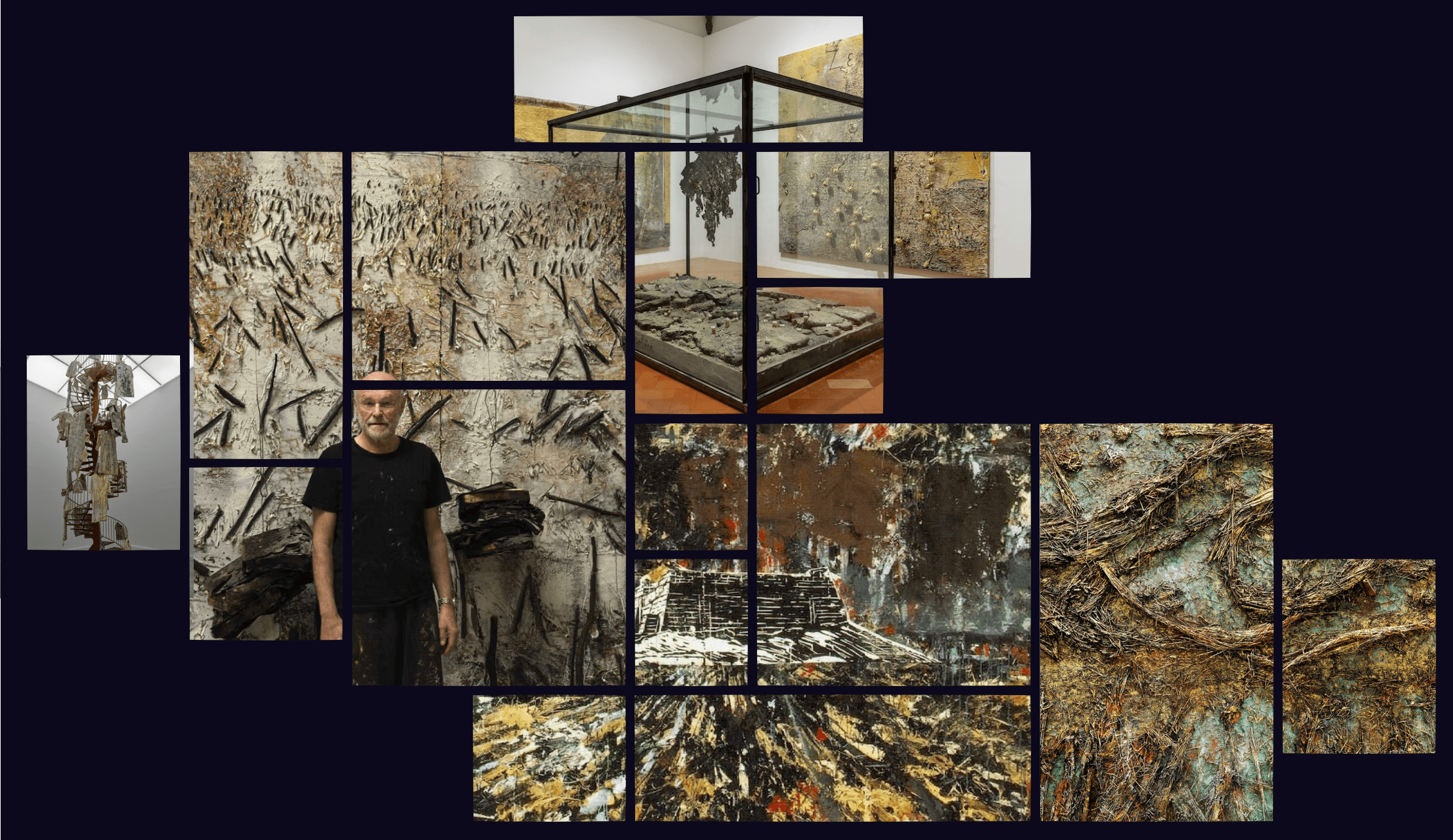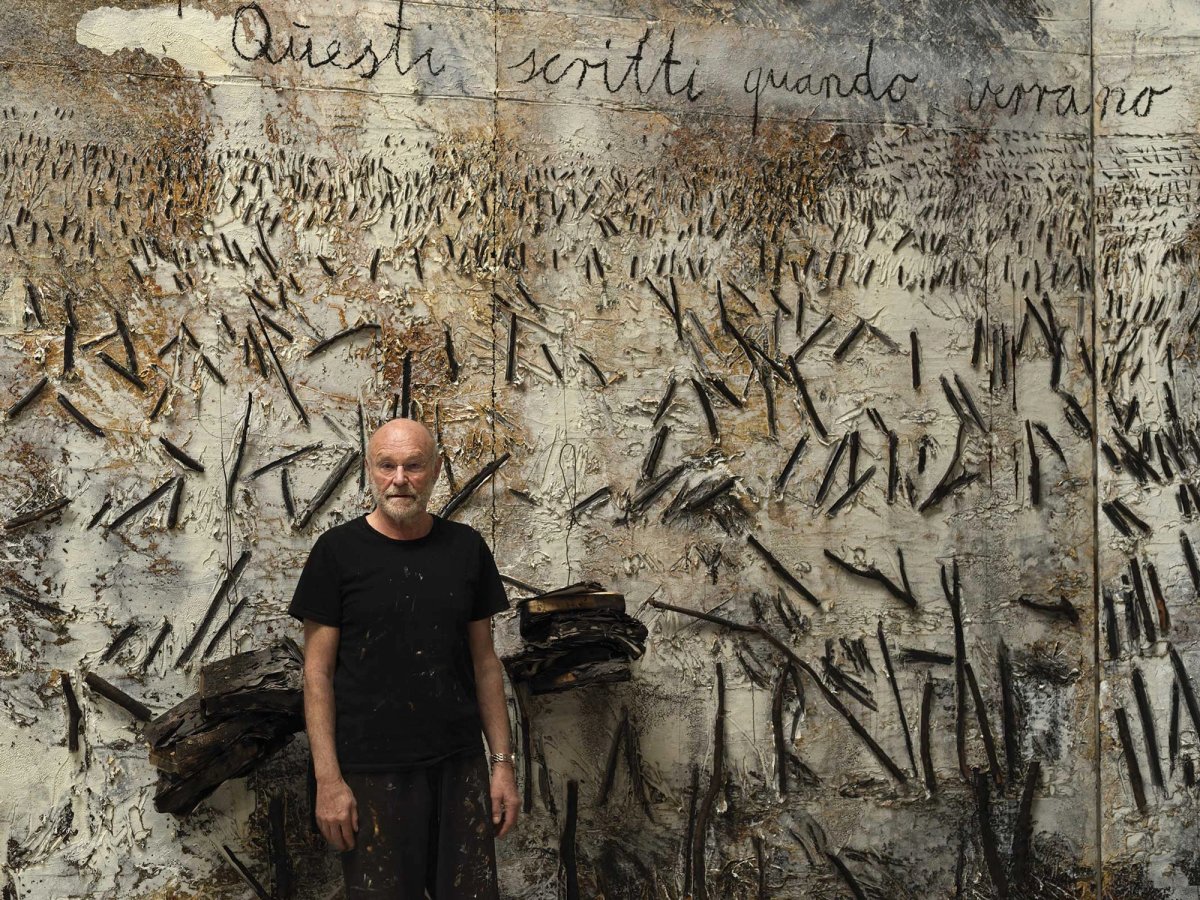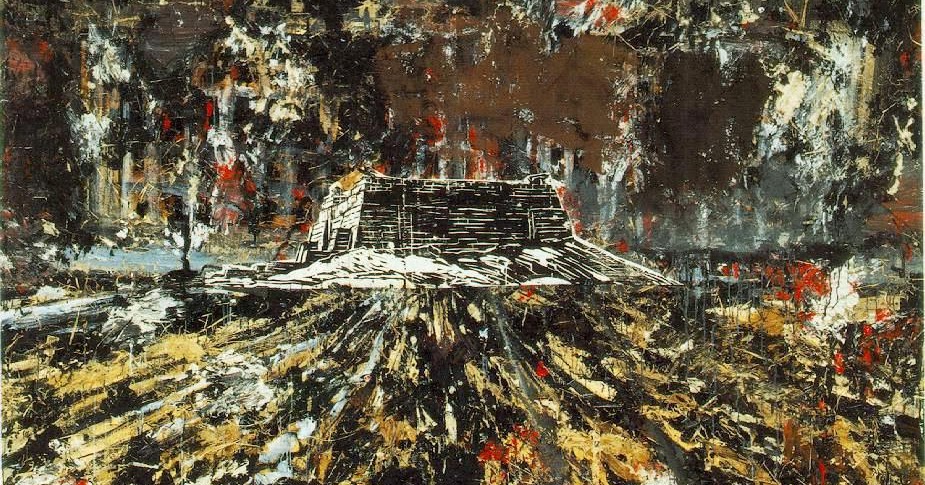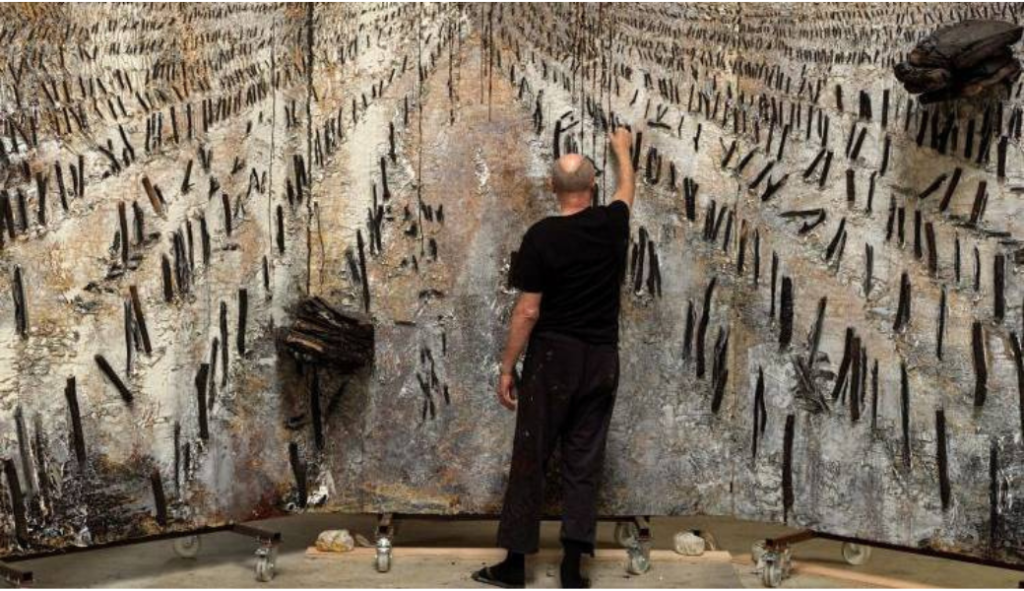Elder voices of the Millenium: Anselm Kiefer
Sara Srifi
Wed Oct 22 2025

Explore Anselm Kiefer's monumental art, delving into history, mythology, and memory. Discover this Elder Voice of the Millennium in his powerful works.
Anselm Kiefer's art is big. Like, really big. And it's heavy, too, not just in size but in subject matter. He tackles history, memory, and all the tough stuff that comes with being human, especially after something like World War II. His work feels like it's speaking from a long way off, like ancient voices are coming through the materials he uses. It's a whole experience, not just looking at a painting or a sculpture.
Key Takeaways
- Kiefer's art grapples with the heavy history of post-war Germany, using materials like lead, ash, and straw to convey deep meaning.
- Mythology and memory are central to his work, acting as bridges between past events and our current lives.
- He transforms everyday and raw materials into powerful symbols, giving them new life and significance.
- His large-scale pieces are a direct engagement with history, making viewers confront the past in a tangible way.
- Kiefer's art explores identity, trauma, and rebirth, reflecting a personal and universal human experience.
Anselm Kiefer's Monumental Engagement with History

Anselm Kiefer’s art doesn't shy away from the heavy stuff. Born in Germany right after World War II, his work is deeply tied to his country's past, especially the difficult parts. He tackles history head-on, not with a light touch, but with a kind of raw, almost alchemical approach.
The Weight of Post-War Germany in His Canvases
Kiefer’s paintings often feel like they carry the physical and emotional burden of post-war Germany. He uses materials that seem to absorb and reflect this history. Think about lead, ash, and straw – these aren't your typical art supplies, are they? They bring a texture and a weight that speaks volumes about destruction, memory, and the struggle to rebuild. His canvases become landscapes of the mind, scarred and layered like the land itself. It’s like he’s trying to excavate the past, bringing its buried stories to the surface.
Mythology and Memory as Enduring Themes
Beyond just German history, Kiefer draws heavily from mythology and collective memory. He weaves together ancient stories, biblical narratives, and historical events into his work. This creates a sense of timelessness, connecting our present struggles with age-old human experiences. It’s a way of saying that certain themes – trauma, rebirth, the search for meaning – are constants throughout history. He’s not just painting; he’s telling stories that have been told for centuries, but with his own unique, often somber, voice.
The Alchemical Transformation of Materials
What’s really striking is how Kiefer treats his materials. He doesn't just apply paint; he seems to transform these raw elements into something new, something charged with meaning. It’s like an alchemist’s process, turning base materials into gold, or in his case, turning mundane substances into powerful symbols. This transformation isn't just physical; it's conceptual, mirroring the way societies and individuals process trauma and memory, turning difficult experiences into something that can be understood, and perhaps, eventually, healed.
Kiefer’s approach to art-making is less about creating pretty pictures and more about confronting the viewer with the raw, often uncomfortable, truths of existence and history. His monumental scale and the visceral nature of his materials demand attention and invite a deep, personal engagement with the themes he explores.
Here’s a look at some of the materials he frequently uses and their general associations:
- Lead: Often linked to melancholy, creative forces, and transmutation.
- Ash: Symbolizes destruction, remnants, and the aftermath of fire or conflict.
- Straw: Can represent fragility, harvest, or the organic and natural world.
- Earth/Soil: Connects to the land, roots, and the physical grounding of history.
Kiefer’s work is a testament to the power of art to engage with history in a profound and lasting way. He shows us that the past isn't just something we read about; it's something we can feel, something that shapes us, and something that art can help us to understand.
Echoes of the Past in Kiefer's Artistic Language

Anselm Kiefer doesn't just paint history; he seems to dig it up, mix it with dirt and ash, and then build something new from the rubble. His approach to materials is pretty wild, honestly. He uses things like lead, straw, and even ash, which aren't your typical art supplies. These aren't just random choices; they're loaded with meaning.
Incorporating Lead, Ash, and Straw
Think about lead. It's heavy, it's toxic, and it's been used for centuries in everything from pipes to paint. For Kiefer, lead often brings up feelings of melancholy and the difficult, sometimes painful, process of creation. It’s like he’s saying that making art, especially art that grapples with heavy historical stuff, isn't always pretty or easy. Then there's straw. It's humble, organic, and often associated with the earth, with harvest, but also with decay. When he uses it, it feels like he's connecting his work directly to the land, to the cycles of life and death that have played out over centuries. And ash? Well, ash is what's left after something has burned, after destruction. It’s a stark reminder of what’s been lost, but also a symbol of potential renewal. It’s a powerful way to talk about Germany’s past without explicitly showing ruins.
The Symbolic Resonance of Found Objects
Beyond these core materials, Kiefer often throws in all sorts of found objects. Bits of metal, dried plants, photographs that look like they’ve been through a war – they all find their way into his work. These aren't just decorative additions. They’re like fragments of memory, pieces of forgotten stories that he’s piecing back together. It makes his paintings feel less like flat surfaces and more like archaeological sites. You can almost feel the weight of the past embedded in them. It’s as if he’s saying that history isn’t just in books; it’s in the stuff we leave behind, the things that get discarded.
Bridging Contemporary Existence with Ancient Narratives
What’s really striking is how Kiefer manages to make these ancient, often difficult, narratives feel relevant today. He’s not just looking backward; he’s using the past to talk about our present condition. His work often has this sense of longing, a kind of searching for meaning in a world that can feel pretty chaotic. It’s like he’s trying to connect our modern anxieties to the timeless human experiences of loss, memory, and the search for something lasting. He pulls from mythology, from history, from philosophy, and weaves it all together into these massive, complex pieces that demand your attention. It’s a way of saying that we’re all part of a much bigger story, a story that stretches back further than we can imagine and continues to unfold.
Elder Voices of the Millennium: Anselm Kiefer's Legacy

A Dialogue with Historical Consciousness
Anselm Kiefer’s work isn't just about pretty pictures or interesting textures; it's a deep dive into the messy, complicated story of humanity, especially post-war Germany. He’s like an archaeologist of memory, digging up the past and showing it to us in ways that are hard to ignore. His art forces us to confront history, not just the big, dramatic events, but the personal and collective traumas that shape who we are. It’s a conversation that spans centuries, bringing voices from long ago right into our present moment.
The Unflinching Advent Longing in His Art
There's a certain kind of yearning in Kiefer's pieces, a feeling that's been described as an "unflinching Advent longing." It’s that sense of waiting, of anticipation for something, perhaps redemption or understanding, that feels deeply human. This longing isn't passive; it's an active, sometimes painful, reaching out. It’s like standing on the edge of something vast, looking for a sign, a resolution, or a new beginning. This feeling is palpable in his large-scale works, where the sheer physicality of the materials seems to echo this profound human desire.
Transmuting Human Experience and the Cosmos
Kiefer has this incredible ability to take the raw stuff of human experience – pain, memory, history – and transform it into something that feels cosmic. He uses materials like lead, ash, and straw, not just because they look interesting, but because they carry their own weight, their own stories. It’s as if he’s performing an alchemical process on the canvas, turning the dross of the past into something that speaks to the vastness of the universe and our place within it. This transmutation connects our individual lives to something much larger, a grand narrative that stretches from the earth beneath our feet to the stars above.
Here's a look at some of the materials he frequently uses and their symbolic weight:
| Material | Symbolic Resonance |
|---|---|
| Lead | Melancholy, creative forces, weight of history |
| Ash | Destruction, remnants, purification |
| Straw | Life, fragility, harvest, decay |
| Gold Leaf | Spirituality, value, transformation |
| Earth/Soil | Grounding, history, decay, rebirth |
Kiefer's art acts as a bridge, connecting the tangible world of materials with the intangible world of ideas, emotions, and historical memory. He doesn't shy away from the difficult aspects of the past; instead, he confronts them head-on, using his art to process and understand them. This engagement with history, memory, and the human condition is what gives his work its enduring power and its connection to the 'elder voices' of time.
Kiefer's Art as a Narrative Medium

Anselm Kiefer doesn't just paint pictures; he crafts entire worlds, each piece a chapter in a much larger story. His work acts like a powerful storyteller, pulling us into historical events, myths, and personal reflections. It’s like he’s building a bridge between the past and the present, using his art to make us feel the weight of history.
Contextualizing Art within Historical Significance
Kiefer often places his art in significant historical locations, like his 2007 exhibition at the Louvre. This wasn't just about showing art; it was about making the art talk to the history already present in the building. He uses the existing narrative of a place to add new layers to his own work, making us think about how art connects with where it's shown.
Transforming Perceptions of Place and Time
When you stand in front of a Kiefer piece, you're not just looking at a canvas. You're stepping into a different time and space. He uses materials like lead, ash, and straw, which carry their own histories and textures. This makes the artwork feel tangible, almost like an artifact itself. It changes how we see the artwork and the stories it tells.
Contemporary Art as a Continuation of Great Narratives
Kiefer seems to believe that contemporary art isn't separate from the grand stories of the past. Instead, it's a continuation. His work takes ancient myths, historical traumas, and philosophical ideas and reinterprets them for our time. It’s a way of saying that the human experience, with all its struggles and longings, is a continuous thread running through history.
Here's a look at how he weaves these narratives:
- Mythology: He draws heavily from ancient myths, giving them a raw, often unsettling, modern feel.
- History: The scars of post-war Germany are a constant presence, explored with unflinching honesty.
- Personal Reflection: Themes of identity, memory, and trauma are woven throughout, making the grand narratives feel deeply personal.
Kiefer's approach is less about providing answers and more about posing profound questions. He uses his art to confront difficult truths, inviting viewers to engage with the complexities of human existence and the enduring echoes of the past. His monumental works are not just objects to be observed, but experiences to be felt.
The Materiality and Scale of Kiefer's Vision

Anselm Kiefer doesn't just paint; he builds worlds. His canvases are often massive, demanding a physical presence from the viewer that mirrors the weight of the subjects he tackles. It's not just about the size, though. It's about what he puts on those canvases. Think less oil paint, more like a sculptor working with a palette knife, but on a grand scale.
Intense Materiality in Large-Scale Works
Kiefer's approach to materials is pretty wild. He uses things like lead, ash, straw, and even dirt. These aren't your typical art supplies, and they bring a whole different kind of energy to the work. The sheer physicality of these materials, combined with the monumental scale of his pieces, creates an immersive experience. It’s like you’re not just looking at a painting, but standing in the middle of a historical event or a myth.
Heterogeneity and Conservation Challenges
All these different materials – metal, organic matter, paint – they don't always play nice together. This makes conserving his work a real headache for museums. You can't just treat a Kiefer like any other painting. It requires special care because the materials themselves are part of the artwork's story and its potential decay. It’s a constant balancing act.
The Tactile Dimension of His Creations
When you look at a Kiefer, you almost feel like you can touch the textures. The rough surfaces, the embedded objects, the way the paint is layered on thick – it all adds a tactile quality. It makes the history and the emotions he's exploring feel more real, more present. It’s a way of making the past tangible, something you can almost feel under your fingertips.
Exploring Identity Through Kiefer's Oeuvre

Anselm Kiefer's art isn't just about big historical events or landscapes; it's also deeply personal. He often uses his work to figure out who he is, especially in the context of Germany's complicated past. It’s like he’s trying to piece together his own identity from the fragments of history he works with.
The Figure of the Lying Man as Self-Portrait
One recurring image in Kiefer's work is the figure of a man lying down. This isn't just a random character; many see it as a stand-in for the artist himself. It’s a way for him to explore his own feelings and place in the world. Think of it as a visual diary entry, but on a massive scale.
- The pose suggests vulnerability and introspection.
- It often appears in landscapes that are scarred or desolate, mirroring an internal state.
- This figure allows Kiefer to confront difficult emotions without directly depicting himself.
Reflections on Trauma and Rebirth
Kiefer's art is full of references to trauma, both personal and collective. He doesn't shy away from the difficult stuff, like the aftermath of war or personal loss. But within that darkness, there's often a sense of hope, a suggestion of renewal. It’s like he’s saying that even after terrible things, there’s a possibility for things to grow again, maybe in a different form.
The materials he uses, like ash and straw, are often seen as symbols of destruction and decay, but they can also represent the potential for new life. It's a cycle he seems to be fascinated by.
The Artist's Exploration of Identity
Ultimately, Kiefer uses his art to grapple with big questions about identity. Who are we when we're shaped by so much history and so many difficult experiences? His work suggests that identity isn't fixed; it's something that's constantly being made and remade, often through a difficult but necessary process of confronting the past. He’s not just painting history; he’s painting the experience of living through it and trying to make sense of it all.
The Echoes Remain
So, when you look at Anselm Kiefer's work, it's more than just paint and straw on a canvas. It's like he's digging into the past, pulling out all these heavy stories and putting them right in front of you. He uses materials that feel old and worn, like lead and ash, which really makes you think about history and what it leaves behind. It’s not always an easy experience, but it’s definitely one that sticks with you, making you ponder the big questions about where we come from and where we're headed. His art is a powerful reminder that the past isn't really gone; it's just waiting to be heard.
Frequently Asked Questions
What is Anselm Kiefer known for in his art?
Anselm Kiefer is famous for making really big art, like paintings and sculptures. He often uses materials like lead, ash, and straw. His work is deeply connected to Germany's history, especially after World War II, and explores big ideas like memory, myths, and who we are.
Why does Kiefer use unusual materials like lead and straw?
Kiefer uses materials like lead, ash, straw, and even dirt because they have a special meaning. These materials can represent the weight of history, the earth, or even a sense of transformation, like an alchemist changing things. They make his art feel very real and textured.
How does Kiefer connect his art to history?
Kiefer's art is like a conversation with the past. He uses symbols and materials that remind people of historical events, myths, and the struggles of his country. By doing this, he helps us think about how history affects us today and how we remember it.
What does Kiefer mean by 'Elder Voices of the Millennium'?
This phrase suggests that Kiefer's art speaks with the wisdom and experiences of past generations, reaching across time. He brings ancient stories and historical weight into his work, making us feel connected to a long timeline of human experience.
Can Kiefer's art be hard to understand?
Sometimes, Kiefer's art can seem complex because it deals with heavy historical and philosophical topics. However, by looking at the materials he uses and the powerful images he creates, you can get a sense of the deep feelings and ideas he's trying to share about life, history, and the universe.
What is the 'Advent longing' mentioned in relation to Kiefer's art?
The 'Advent longing' refers to a feeling of hopeful waiting for something important to happen, like a spiritual renewal or a resolution. Kiefer's art often has this sense of anticipation, a deep desire for change or understanding, especially when thinking about difficult parts of history.
previous
Mastering The Art of Letting Go: Strategies for a Lighter, Happier Life
next
Beyond the Peaks: How Mountains Transform Your Mental Health
Share this

Sara Srifi
Sara is a Software Engineering and Business student with a passion for astronomy, cultural studies, and human-centered storytelling. She explores the quiet intersections between science, identity, and imagination, reflecting on how space, art, and society shape the way we understand ourselves and the world around us. Her writing draws on curiosity and lived experience to bridge disciplines and spark dialogue across cultures.
More Articles

Beyond the Peaks: How Mountains Transform Your Mental Health

Mastering The Art of Letting Go: Strategies for a Lighter, Happier Life

Unpacking The Science Behind Social Media Algorithms: How They Shape Your Online Experience

The Importance and Implications of Rhythm in Nature: Unveiling Earth's Rhythmic Symphony





